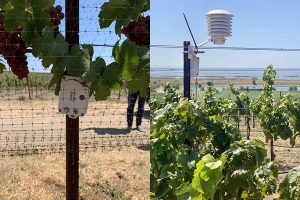- I tested a Pixel Tablet without any Google apps, and it's more private than even my iPad
- My search for the best MacBook docking station is over. This one can power it all
- This $500 Motorola proves you don't need to spend more on flagship phones
- Finally, budget wireless earbuds that I wouldn't mind putting my AirPods away for
- I replaced my Linux system with this $200 Windows mini PC - and it left me impressed
Growing quality wine grapes with less water – Cisco Blogs

Mother Nature throws twists into food growing and production. Even slight changes in temperature, light, and humidity can affect taste or lead to spoilage. California’s grape growers, for instance, are having to adapt to a water shortage. Too much watering is not sustainable—and often not good for fruit quality. Too little, and vines don’t produce or wither away. Food distribution is also ultra-sensitive to environmental conditions. An unnoticed change in the temperature or humidity of warehouses and refrigeration units, for instance, can trigger safety or quality problems.
Industrial IoT sensors make growers instantly aware of changes
Bouchaine Vineyards shows what’s possible when food producers or businesses with a focus on agriculture use Cisco industrial sensors to keep close tabs on the environment. With 104 acres in California’s famous Napa Valley, Bouchaine is a leading producer of sustainably farmed Chardonnay and Pinot Noir. The sustainability focus is something Bouchaine and Cisco have in common. We recently announced our commitment to become net zero for greenhouse gas (GHG) emissions by 2040. Winemakers throughout history relied on their eyes and taste buds to make decisions about irrigation, leafing, fruit thinning, and when to harvest. In 2021, Bouchaine’s winemaker and general manager, Chris Kajani, decided to augment her own senses with data from the industrial internet of things (IoT). The idea: monitor data from industrial sensors installed in multiple vineyard “blocks” with different soils, grape varieties, and topological features.
 Insights about the environment help Bouchaine conserve water
Insights about the environment help Bouchaine conserve water
To keep the focus on growing grapes and making wine, not IT, Chris and her team wanted a simple solution. They found it in Cisco Industrial Asset Vision, an all-in-one solution including different kinds of industrial sensors (temperature, light, humidity, etc.), gateways that collect data from sensors, and a cloud-based dashboard to view data. Everything works together out of the box. “Installing the sensors and gateways was as simple as scanning their bar codes,” Chris told me. The whole solution was up and running within an hour.
Throughout the 2021 growing season, Bouchaine monitored temperature, light, and humidity of individual vineyard blocks in more detail than ever before—with a glance at the dashboard. Temperature data figured into decisions about when and where to irrigate. “The Cisco sensors are helping us preserve one of our most precious resources—water,” Chris said. “We’re using the data to water only when and where it’s absolutely necessary.” The combination of temperature and light data—tannins ripen in light—helps the team decide which blocks to harvest, when, and plan for future seasons. “The sensor data gives us peace of mind that we’ll see changes in the vineyard when there’s still time to take action,” Chris said.

Now Bouchaine is getting ready to install more sensors to understand the environment in smaller sections of the vineyard, and to put the data to use in new ways. Bouchaine has also become an industry leader for virtual wine tastings. Bouchaine wine aficionados, who are shipped wines to taste, can join a Cisco Webex session from any location to learn more about the wines with a private host, without the need to travel. Along with a livestream of the vineyard, they can see current temperature, light, and humidity readings from the Cisco sensors and learn about the impact on the grapes. In this way Bouchaine is truly harnessing the possibilities enabled by new technologies.
All-in-one solution is simple to deploy and use
The idea of using sensors for sustainable food growing and production isn’t new. The roadblock until now has been the complexity. We kept simplicity top of mind when we designed Industrial Asset Vision. The ruggedized sensors and gateways are designed to withstand temperature swings, rain, and wind. Installing sensors and gateways is as simple as scanning their bar codes, and sensors even come with batteries. The gateways can connect sensors spread over a large area, reducing the number of gateways to buy and maintain. And we’ve put our expertise in networking and security to work to make sure data remains private.
Learn more
In addition to agriculture, Industrial Asset Vision helps support better decisions in food manufacturing, warehousing, and refrigeration. We build complete, end-to-end industrial IoT solutions by combining Industrial Asset Vision with our industrial IoT switches and routers. To learn more, I invite you to check out:
Subscribe to our newsletter to keep up with the latest Internet of Things trends and insights to help you succeed with your IoT deployments.
Share:

